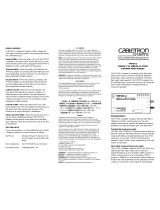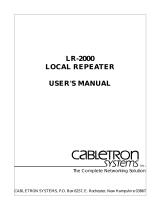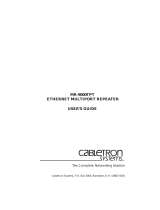Page is loading ...

E1100, E2100, AND E3100 SERIES
ETHERNET NETWORK ADAPTERS
INSTALLATION GUIDE
Desktop Network Interface Products
C A B L E T R O N S Y S T E M S, I N C.

NOTICE
i
NOTICE
Cabletron Systems reserves the right to make changes in
specifications and other information contained in this document
without prior notice. The reader should in all cases consult Cabletron
Systems to determine whether any such changes have been made.
The hardware, firmware, or software described in this manual is
subject to change without notice.
IN NO EVENT SHALL CABLETRON SYSTEMS BE LIABLE FOR
ANY INCIDENTAL, INDIRECT, SPECIAL, OR CONSEQUENTIAL
DAMAGES WHATSOEVER (INCLUDING BUT NOT LIMITED TO
LOST PROFITS) ARISING OUT OF OR RELATED TO THIS
MANUAL OR THE INFORMATION CONTAINED IN IT, EVEN IF
CABLETRON SYSTEMS HAS BEEN ADVISED OF, KNOWN, OR
SHOULD HAVE KNOWN, THE POSSIBILITY OF SUCH
DAMAGES.
Copyright October 1992
Cabletron Systems, Inc.
35 Industrial Way, P.O. Box 5005
Rochester, NH 03867-0505
All Rights Reserved
Printed in the United States of America
Order number: 9030445-02 October 92
Multi Media Access Center, LANVIEW and Remote LANVIEW are
registered trademarks and Desktop Network Interface, E1100, E2100,
E3100, FOT-F, LAN-MD, and MMAC are trademarks of Cabletron
Systems, Inc.
SunNet Manager is a registered trademark of Sun Microsystems, Inc.
IBM, IBM Personal Computer AT, Micro Channel, IBM Personal
System/2 and PS/2 are registered trademarks of International
Business Machines Corporation. IBM Personal Computer XT and PC
LAN are trademarks of International Business Machines Corporation.
MS-DOS is a trademark of Microsoft Corporation.
Novell and NetWare are registered trademarks of Novell, Inc.

FCC NOTICE
ii
FCC NOTICE
This device complies with Part 15 of FCC rules. Operation is subject
to the following two conditions: (1) this device may not cause
harmful interference, and (2) this device must accept any interference
received, including interference that may cause undesired operation.
WARNING: This equipment has been tested and found to comply
with the limits for a Class A digital device, pursuant to Part 15 of FCC
Rules. These limits are designed to provide reasonable protection
against harmful interference when the equipment is operated in a
commercial environment. This equipment uses, generates, and can
radiate radio frequency energy and if not installed in accordance with
the operator’s manual, may cause harmful interference to radio
communications. Operation of this equipment in a residential area is
likely to cause interference in which case the user will be required at
his own expense to correct the interference.
If this equipment does cause interference to radio or television, which
can be determined by turning the equipment off and on, the user is
encouraged to try to correct the interference by one or more of the
following measures:
• Re-orient the receiving antenna.
• Relocate the computer with respect to the antenna.
• Move the computer away from the receiver.
• Plug the computer into a different outlet so that the computer
and the receiver are on different branch circuits.
If necessary, the user should consult the dealer or an experienced
radio/television technician for additional suggestions. The user may
find the following booklet prepared by the Federal Communication
Commission helpful:
“Interference Handbook”
This booklet is available from the U.S. Government Printing Office,
Washington D.C. 20402 - Stock No. 004-000-00482-5.

CONTENTS
iii
CONTENTS
CHAPTER 1 INTRODUCTION
1.1 Using This Manual ....................................................................1-1
1.2 The Adapter Features ...............................................................1-2
1.2.1 Connectivity ...................................................................1-2
1.2.2 Thin Ethernet Port .........................................................1-2
1.2.3 10BASE-T Twisted Pair Port ........................................1-2
1.2.4 Fiber Optic Ports ............................................................1-3
1.2.5 Jabber Protection............................................................1-3
1.2.6 LANVIEW LEDs ............................................................1-3
1.2.7 Software ..........................................................................1-5
1.2.8 Statistics...........................................................................1-5
1.3 Related Manuals ........................................................................1-5
CHAPTER 2 INSTALLATION
2.1 Adapter Models.........................................................................2-1
2.1.1 Model Number References...........................................2-2
2.2 The E1100/E2100 Series Adapters ..........................................2-2
2.2.1 Unpacking the Adapter ................................................2-3
2.2.2 Copying the Software....................................................2-3
2.2.3 Preparing the E1100 for Installation............................2-3
2.2.4 Preparing the E2100 for Installation............................2-4
2.3 Setting the I/O Base Address Jumper ....................................2-5
2.4 I/O Address Space Requirements ..........................................2-6
2.5 Installing a Boot PROM ............................................................2-6
2.6 Installing the E1100/E2100 Adapters.....................................2-7
2.7 Installing the E3100 Series Adapters ....................................2-10
2.7.1 Preparing the E3100 Series for Installation ..............2-10
2.7.2 E3100 Series Boot PROM ............................................2-10
2.7.3 Installing the E3100 Adapter ......................................2-11
2.8 Copying the ADF File .............................................................2-14
2.9 Loading Network Software ...................................................2-14
2.10 Troubleshooting Check List for Adapters ...........................2-15

iv
CONTENTS
2.11 Software Check List ................................................................2-15
2.12 Getting Help ............................................................................2-16
2.13 Specifications ...........................................................................2-18
2.13.1 Power Requirements ...................................................2-18
2.13.2 Environmental Requirements ....................................2-18
2.13.3 Safety .............................................................................2-18
2.13.4 Dimensions ...................................................................2-18
CHAPTER 3 MAKING NETWORK CONNECTIONS
3.1 Connecting to a Twisted Pair Segment ..................................3-1
3.1.1 RJ-45 Interface (UTP Port) ............................................3-1
3.1.2 Twisted Pair Requirements ..........................................3-3
3.2 Connecting to a Thin-net Segment .........................................3-4
3.2.1 BNC Interface (Coax Port) ............................................3-4
3.2.2 Thin-Net Requirements ................................................3-5
3.3 Connecting to a Fiber Optic Link Segment............................3-6
3.3.1 Fiber Optic Requirements.............................................3-7
3.3.2 Fiber Optic Interface (Fiber Optic Ports) ....................3-8
3.4 Connecting to an External Transceiver ..................................3-9
3.4.1 AUI Connector (AUI Ports) ..........................................3-9
3.4.2 AUI Interface ................................................................3-10
3.4.3 AUI Cable Requirements ............................................3-10
APPENDIX A ADDRESS/INTERRUPT TABLES
INDEX

INTRODUCTION
Page 1-1
CHAPTER 1
INTRODUCTION
This manual provides installation and reference information for
the network adapters. The network adapters connect your PC to: a
10BASE-T twisted pair Ethernet network segment, a thin Ethernet
10BASE-2 coaxial network, a fiber optic network segment, or a
transceiver via an AUI cable.
The adapters incorporate Cabletron Systems’ LANVIEW
LEDs.
These diagnostic LEDs indicate power, network transmit and
receive, link established, and collision present conditions as soon
as the adapter is connected to the network segment.
1.1 USING THIS MANUAL
This manual is organized so that you can follow sequential
chapters as you install the adapter. Read Chapter 1 first to
familiarize yourself with the adapter’s capabilities. Then:
• Copy the software diskettes supplied with the adapter.
• Install the adapters as outlined in Chapter 2.
• Run the diagnostic program supplied with the adapter.
• Connect the adapter to the network as outlined in Chapter 3.
• Install the network drivers required for your application as
outlined in the Network Software Installation Guide.
Chapter 1, Introduction, discusses the capabilities of the adapters.
Chapter 2, Installation, provides instructions for installing the
adapters in your computer.
Chapter 3, Making Network Connections, provides instructions
and requirements for connecting your adapters to the network.

INTRODUCTION
Page 1-2
1.2 THE ADAPTER FEATURES
The following sections outline the features of the adapters.
1.2.1 Connectivity
The Cabletron Systems adapters connect your computer to an
IEEE 802.3 Ethernet network. The various adapter models
incorporate either an Ethernet 10BASE-T twisted pair port, a thin
Ethernet coaxial BNC port, an SMT type fiber optic port, or an
external transceiver via an AUI cable. All port types provide
access for SNMP network management such as Cabletron’s
SPECTRUM
, Remote LANVIEW
/Windows, or any SNMP-
compliant management software.
1.2.2 Thin Ethernet Port
The adapter’s 10BASE-2 port provides a thin Ethernet BNC
connection to a coaxial segment such as the backbone of a
corporate-wide network, or to a concentrator such as Cabletron’s
MMAC Multi Media Access Center
.
1.2.3 10BASE-T Twisted Pair Port
The adapter’s 10BASE-T twisted pair port employs the RJ-45
eight-pin industry standard connector which must be connected
to a concentrator such as Cabletron’s MMAC Multi Media Access
Center. The 10BASE-T twisted pair port on the adapter has built-
in automatic polarity detection and correction. This means that if
the cable connected to the twisted pair port should have the RX+
and RX– leads reversed, the port circuitry will automatically
detect and correct this problem.
When polarity correction has occurred, the link LED flashes to
indicate that this automatic correction has been performed.
Performance will not be impacted.

INTRODUCTION
Page 1-3
1.2.4 Fiber Optic Ports
The fiber optic ports on the adapter employs two ST type fiber
optic connectors. The dark gray ST connector is the fiber optic
receive port and light gray ST connector is the fiber optic transmit
port. The ST connector fiber optic ports can utilize
50/125 µm, 62.5/125 µm, and 100/140 µm fiber optic cables.
1.2.5 Jabber Protection
A built-in jabber protection scheme ensures that the network is
not disabled due to the transmission of excessively long packets
(jabber). This protection scheme automatically interrupts the port
for 96 bit times (1 bit time = 100 ns.) if the port has been
transmitting continuously for more than 65,536 bit times.
1.2.6 LANVIEW LEDs
Cabletron Systems’ adapters incorporate Cabletron Systems’
LANVIEW Status Monitoring and Diagnostic System. The
LANVIEW LEDs help you diagnose problems, such as failure to
establish a twisted pair link between the adapter and an Ethernet
device at the far end of the link. Individual LEDs advise you when
the adapter is receiving or transmitting data packets, or when a
collision condition exists on the network (see Figure 1-1).
• Media Link Good (LNK) LED fiber optic adapters
When lit, this green LED indicates that a link has been established
between the fiber optic port on the adapter and the fiber optic
device at the other end of the fiber optic link segment. This LED
remains lit as long as the link is maintained.
• Link OK (LNK) 10BASE-T only
When lit, this LED indicates that a link has been established
between the adapter and the device at the other end of the
Ethernet segment (green indicator).

INTRODUCTION
Page 1-4
XMT
RCV
CP
LNK or
PWR
Dual Media Adapter
Dual Port Adapter
XMT
RCV
CP
LNK
LNK
Upper Po
rt
Lower Por
t
RJ-45 Port
RJ-45 Port
RJ-45 Port
BNC Port
Figure 1-1. LANVIEW LEDs
• Collision Present (CLN)
This LED flashes when the adapter is transmitting to indicate that
the adapter is detecting a collision condition on the network (red
indicator).
• Receive (RCV) network traffic
This LED flashes to indicate that the adapter is receiving data
packets from the network (yellow indicator).
• Transmit (XMT)
This LED flashes to indicate the adapter is transmitting packets
onto the network (green indicator).

INTRODUCTION
Page 1-5
1.2.7 Software
Software drivers, related software, and diagnostics are supplied
by Cabletron Systems on floppy diskettes shipped with the
adapter. The drivers support a variety of network platforms. Refer
to the Network Software Installation Guide.
The diagnostic program provided with the adapter allows you to
check the adapter’s operation at various levels, through a series of
tests. The diagnostic program allows you to detect where a
problem might be located in the operation of the adapter, or
determine if a problem exists in the communication between the
adapter and the computer.
1.2.8 Statistics
Statistics can be gathered from the adapter either from your
computer, or from another workstation utilizing Cabletron
Systems’ SPECTRUM, Remote LANVIEW/Windows, Remote
LANVIEW for SunNet Manager
, or other SNMP-compliant
network management software. Through this software, you can
gather statistics on the adapter’s activity on the Ethernet network.
For further information on Local Statistics, refer to the Network
Software Installation Guide.
1.3 RELATED MANUALS
• TPT-T 10BASE-T Transceiver User’s Manual
• Remote LANVIEW/Windows Station Software
User’s Manual
• SPECTRUM documentation
• Network Software Installation Guide

INSTALLATION
Page 2-1
CHAPTER 2
INSTALLATION
2.1 ADAPTER MODELS
The E1100, E2100, and E3100 Series network adapters are used for
the specific computer bus architectures listed below:
• E1100 Series - IBM Personal Computer XT, IBM Personal
Computer AT
, IBM Personal System/2
Models 25 or 30, or a
compatible with an XT or an AT style bus.
• E2100 Series - IBM Personal Computer AT, IBM Personal
System/2 Model 30, or a compatible with an AT style bus.
• E3100 Series - IBM Personal System/2 or compatibles with a
Micro Channel
style bus.
Each type of adapter is available with a large memory option for
use in more demanding network environments. Large memory is
indicated by a - X appended to the adapter model number.
Table 2-1. Ethernet Adapter Model Number Reference
E
21 1 2 -X
Topology Bus Type 1st Media 2nd Media Options
E- Ethernet 11 - XT 0 - AUI 0 - AUI -X Large
Memory
21 - AT 1 - Tw. Pair 1 - Tw. Pair
31 - MC 2 - Coax 2 - Coax
3 - Fiber SMA 3 - Fiber SMA
4 - Fiber ST 4 - Fiber ST
9 - N/A

Page 2-2
INSTALLATION
2.1.1 Model Number References
The descriptions of Ethernet adapter features use model numbers
with a lower case x in them. The x indicates that any number from
the model number reference chart applies to that feature. The
model number E11xx indicates an E1100 series adapter with any
media combination has the described feature. For example, an
E1112 is an E1100 Series adapter with UTP and coax ports. A
model with the suffix -X indicates a large memory option. The
optional memory sizes are listed below:
• E1100 Series - 8 KB, E1100-X Series - 32 KB
• E2100 Series - 16 KB, E2100-X Series - 64 KB
• E3100 Series - 16 KB, E3100-X Series - 64 KB
2.2 THE E1100/E2100 SERIES ADAPTERS
This chapter shows you how to prepare an E1100 or E2100 Series
Cabletron Systems’ network adapter and install it in your
computer. The I/O base address and Boot PROM address are
hardware configurable for the E1100 and E2100 Series adapters,
while the other parameters are set through software. The
preparation and installation procedure for the adapter consists of
the following steps:
• Unpacking the adapter and software
• Making a backup copy of the software
• Configuring and installing the adapter
• Running diagnostics
• Making network connections
• Installing network drivers

INSTALLATION
Page 2-3
2.2.1 Unpacking the Adapter
The network adapter and its software are shipped separately. The
complete installation package should contain one conductive
pouch with the adapter and this manual. The software is shipped
in a shrink-wrapped package containing the software, a license
agreement, and a Network Software Installation Guide.
Carefully remove the conductive pouch from the box. Leave the
adapter in the conductive pouch until you are ready to install it.
Open the shrink-wrapped software package when you are ready
to install the software. Be sure to read the license agreement.
CAUTION: The adapter is sensitive to static discharges. Hold it by the
corners. Avoid contact with the PC bus edge connector or any of the
components, except the jumpers. Failure to observe all static precautions
can result in damage to the adapter.
2.2.2 Copying the Software
Before you begin the installation, it is important that you make a
backup copy of the Cabletron software supplied with the adapter.
Use the disk copy routine for your PC to make a duplicate copy of
the Cabletron software diskettes. Store the original software in a
safe place, and use the copies for the actual installation procedure.
2.2.3 Preparing the E1100 for Installation
The E11xx Series employs a socket for an optional Boot PROM. All
parameters except the I/O base address and PROM base address
are set through software. Instructions are included for setting the
I/O base address, and installing the Boot PROM. Figure 2-1, an
E1112 adapter, shows the locations of the jumpers and Boot
PROM socket. Boot PROM addressing is covered in the
installation instructions included with the Boot PROM.

Page 2-4
INSTALLATION
JP2
ROM
Enable
JP1
I/O Base
Address
Boot PROM
Socket
Figure 2-1. The E1112 Adapter
2.2.4 Preparing the E2100 for Installation
The E21xx Series employs a socket for an optional Boot PROM. All
parameters except the I/O base address and PROM base address
are set through software. Instructions are included for setting the
I/O base address, and installing the Boot PROM. Figure 2-2, an
E2112 adapter, shows the locations of the jumpers and Boot
PROM socket. Boot PROM addressing is covered in the
installation instructions included with the Boot PROM.
JP2
ROM Enable
JP1
I/O Base Address
Boot PROM Socket
Figure 2-2. The E2112 Adapter

INSTALLATION
Page 2-5
2.3 SETTING THE I/O BASE ADDRESS JUMPER
The I/O base address Jumper, JP1, must be set to one of four
possible addresses before the adapter is installed. The I/O base
address jumper sets the I/O (input/output) base address that
identifies the adapter to the PC.
The I/O base address is a hexadecimal field that distinguishes the
adapter from other adapters that may be in the PC. Two shunts are
supplied with the jumper in the event you want to use the 220
address setting. Figures 2-1 and 2-2 show the JP1 jumper’s
location.
To set the I/O base address jumper, JP1 (Figure 2-3), hold the
adapter so the components are facing you and the ports are on
your right.
1
3
2
4
Figure 2-3. JP1, E1100/E2100 I/O base address Jumper Pins
220 280 300 380
Figure 2-4. I/O Base Address Settings
Select one of four possible I/O base addresses by placing shunts
on the JP1 pins as shown in Figure 2-4. Note that address 220
requires the use of both shunts. No shunts are required for the
default address 380.

Page 2-6
INSTALLATION
2.4 I/O ADDRESS SPACE REQUIREMENTS
The I/O address space for the E1100 and E2100 Series adapters
occupies 20 Hex of the selected I/O base address. For example, if
you select 220 Hex, the adapter I/O address range will extend
through 23F Hex.
Note that 23F lies within the address space (230 to 240) allotted to
the bus mouse. If your system uses a bus mouse, address 220
cannot be used for the adapter because of the address conflict with
the bus mouse. Appendix A, Address/Interrupt Tables, lists the
I/O addresses of commonly used devices.
2.5 INSTALLING A BOOT PROM
The E1100 and E2100 Series adapters have a socket for an optional
Boot PROM. The Boot PROM plugs into the empty 28-pin socket
shown in Figures 2-1 and 2-2.
By installing a Boot PROM, you can use the adapter to boot up
your PC, without a hard drive, onto a network running, for
example, the Novell
NetWare network operating system. A Boot
PROM address jumper (JP2) must be set before the Boot PROM
can be used, however.
Figure 2-5. Boot PROM and Socket Alignment
CAUTION: Observe all precautions when handling the Boot PROM.
Static discharges may damage the Boot PROM.

INSTALLATION
Page 2-7
To install a Boot PROM, remove the Boot PROM from its
packaging. Ensure that the legs of the Boot PROM are aligned in a
90° angle with the PROM body so the legs of the Boot PROM are
perpendicular to the Boot PROM pin sockets. Insert the Boot
PROM into the PROM socket so that the notch in the PROM is
aligned with the notch in the socket as shown in Figure 2-5.
Refer to the Boot PROM installation instructions included with the
PROM for setting Boot PROM parameters.
Refer to your PC user manual for further information on selecting
a Boot PROM address for your application.
2.6 INSTALLING THE E1100/E2100 ADAPTERS
Note that any of the E1100 and E2100 Series adapters can be
installed in either an XT or an AT style expansion slot. The E1100
adapter will occupy the forward half of the bus connector in an AT
style bus.
CAUTION: The adapter is sensitive to static discharges. Hold it by the
corners. Avoid contact with the PC bus edge connector or any of the
components, except the jumpers. Failure to observe all static precautions
may result in damage to the adapter.
Follow these steps to install the adapter in your computer:
• Turn off the power to the PC and peripherals and disconnect
all power cords and cables.
• Following the instructions in your computer user manual,
using static discharge precautions, remove the cover from the
computer.
• Select the slot in which the adapter will be installed. An E1100
adapter can occupy any XT style, 8-bit expansion slot, or an AT
style, 16-bit expansion slot. An E2100 can occupy any 16-bit
expansion slot or an XT type slot, but in an 8-bit slot,
performance will be degraded.

Page 2-8
INSTALLATION
• Carefully remove the adapter from its protective pouch, and
visually inspect it.
• Remove the backplate (2, Fig. 2-6) from the selected slot (3)
by removing the screw (1) holding the backplate in place, and
sliding the backplate out of the slot as shown in Figure 2-6.
Carefully insert the adapter into the expansion slot as shown in
Figures 2-7 and 2-8. Orient the adapter (1) so the PC edge bus
connector (2) is pointed down and the ports face out the back of
the PC. Align the adapter so the PC bus edge connector is lined up
with the expansion slot (3), and firmly press, but do not force, the
adapter into the slot.
3
2
1
1. Screw
2. Backplate
3. Expansion Slo
t
Figure 2-6. Backplate Detail

INSTALLATION
Page 2-9
1. Adapter
2. PC Board Connector
3. Expansion Slot
1. Adapter
2. PC Board Connector
3. Expansion Slot
1
2
3
Figure 2-7. Installing the E1100 Series Adapter
1
2
3
Figure 2-8. Installing the E2100 Series Adapter

Page 2-10
INSTALLATION
Reinsert the screw removed in disassembly and replace the PC
cover. Reattach the power and peripheral cables and turn on the
power for the PC and the peripherals.
2.7 INSTALLING THE E3100 SERIES ADAPTERS
This section contains instructions for preparing and installing
your Cabletron Systems E3100 Series network adapter into your
computer. The only hardware preparation for installing the E3100
Series adapter is the installation of an optional Boot PROM.
2.7.1 Preparing the E3100 Series for Installation
The parameters for the E3100 Series adapters are set when the
Adapter Description File (ADF) is configured. The ADF file
distinguishes the adapter from other boards in the computer. The
ADF will be configured after the adapter is installed.
CAUTION: The adapter is sensitive to static discharges. Hold it by the
corners. Avoid contact with the PC bus edge connector or any of the
components. Failure to observe all static precautions may result in
damage to the adapter.
2.7.2 E3100 Series Boot PROM
The E3100 Series adapters each have a socket for an optional Boot
PROM, which is purchased separately. By installing a Boot
PROM, you can use the adapter to boot up your PC, without a
hard drive, onto a network running for example, the Novell
NetWare network operating system. The Boot PROM is
configured with the necessary parameters when configuring the
Adapter Description File, as described in Section 2.8. Refer to
Figure 2-9 for the location of the Boot PROM socket. See Boot
PROM installation instructions included in Section 2.5. An E3112
is shown in Figure 2-1.
CAUTION: Observe all precautions when handling the Boot PROM.
Static discharges may damage the Boot PROM.
/









